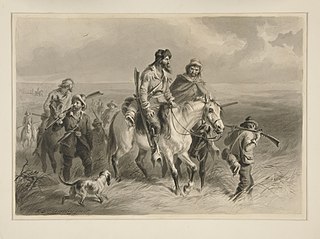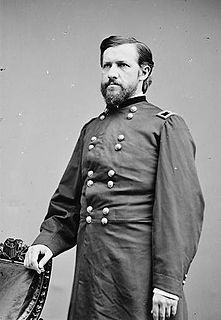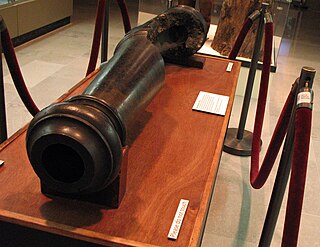
Douglas County is located in the U.S. state of Kansas. As of the 2020 census, the county population was 118,785, making it the fifth-most populous county in Kansas. Its county seat and most populous city is Lawrence.

Lawrence is the county seat of Douglas County and sixth-largest city in Kansas. It is in the northeastern sector of the state, astride Interstate 70, between the Kansas and Wakarusa Rivers. As of the 2020 census, the population of the city was 94,934. Lawrence is a college town and the home to both the University of Kansas and Haskell Indian Nations University.

Bleeding Kansas, Bloody Kansas, or the Border War was a series of violent civil confrontations in Kansas Territory, and to a lesser extent in western Missouri, between 1854 and 1859. It emerged from a political and ideological debate over the legality of slavery in the proposed state of Kansas.

Wilson Shannon was a Democratic politician from Ohio and Kansas. He served as the 14th and 16th governor of Ohio, and was the first Ohio governor born in the state. He was the second governor of the Kansas Territory.

During the events leading to the American Civil War, border ruffians was the derogatory name for proslavery raiders from the slave state of Missouri, who crossed into Kansas Territory to induce violence that peaked from 1854 to 1858 to force the acceptance of slavery.

The sacking of Lawrence occurred on May 21, 1856, when pro-slavery settlers, led by Douglas County Sheriff Samuel J. Jones, attacked and ransacked Lawrence, Kansas, a town which had been founded by anti-slavery settlers from Massachusetts who were hoping to make Kansas a free state. The incident fueled the irregular conflict in Kansas Territory that later became known as Bleeding Kansas.

The 34th United States Congress was a meeting of the legislative branch of the United States federal government, consisting of the United States Senate and the United States House of Representatives. It met in Washington, D.C., from March 4, 1855, to March 4, 1857, during the last two years of Franklin Pierce's presidency. The apportionment of seats in the House of Representatives was based on the Seventh Census of the United States in 1850. The Whig Party, one of the two major parties of the era, had largely collapsed, although many former Whigs ran as Republicans or as members of the "Opposition Party." The Senate had a Democratic majority, and the House was controlled by a coalition of Representatives led by Nathaniel P. Banks, a member of the American Party.
The Wakarusa War was an armed standoff that took place in the Kansas Territory during November and December 1855. It is often cited by historians as the first instance of violence during the "Bleeding Kansas" conflict between anti-slavery and pro-slavery factions in the region.

Thomas Ewing Jr. was an attorney, the first chief justice of Kansas and leading free state advocate, Union Army general during the American Civil War, and two-term United States Congressman from Ohio, 1877–1881. He narrowly lost the 1880 campaign for Ohio Governor.

Walter Roscoe Stubbs was 18th Governor of Kansas. Stubbs, a progressive Republican, was known for his prohibitionist beliefs, as well as for having signed the nation's first blue sky law into effect.

The Liberty Arsenal, known by Federal authorities as the Missouri Depot was a United States Army arsenal at Liberty, Missouri in Clay County, Missouri. The depot was seized twice by Southern partisans, once during the Kansas troubles in 1855, and again shortly after the outbreak of the American Civil War. It was located generally west of the junction of Missouri Route 291 and old 210 Highway.
The 1st Kansas Infantry Regiment was an infantry regiment that served in the Union Army during the American Civil War. On August 10, 1861, at the Battle of Wilson's Creek, Missouri, the regiment suffered 106 soldiers killed in action or mortally wounded, one of the highest numbers of fatalities suffered by any Union infantry regiment in a single engagement during the American Civil War.

Samuel Newitt Wood was an American attorney, politician, and Free State advocate in Kansas.
Samuel Walker was an American soldier, lawman and politician who settled in Lawrence, Kansas and served as an officer during Bleeding Kansas and the American Civil War.
Franklin is a ghost town in Douglas County, Kansas, United States. Established as a proslavery stronghold, the town played a key role in the "Bleeding Kansas" conflict that troubled the territory in the 1850s.
Franklin's Fort was a small fortification that had been erected in Franklin, Douglas County, Kansas by pro-slavery settlers. During the "Bleeding Kansas" period, the fort was the site of two minor battles between pro- and anti-slavery factions.
The Battle of Fort Titus was a battle that occurred during conflicts in the Kansas Territory between abolitionist and pro-slavery militias prior to the American Civil War. The era is known as Bleeding Kansas.
Fort Titus was the fortress residence of pro-slavery advocate Henry T. Titus, built in Kansas in April 1856, during a period when forces aligned with Titus came into conflict with free-state settlers. The wider conflict, which emerged from a political and ideological debate over the legality of slavery in the proposed state of Kansas, became known as Bleeding Kansas.

Samuel Jefferson Jones was a pro-slavery settler who held the position of Douglas County sheriff in Kansas Territory from late 1855 until early 1857. He helped found the territorial capital of Lecompton and played a prominent role in the "Bleeding Kansas" conflict.
Newell W. Spicer was a Union Army lieutenant colonel of volunteers during the American Civil War and a commander of the 1st Regiment Kansas Volunteer Infantry. He was also a leader of pro-abolitionist forces during Bleeding Kansas, a violent period in the history of Kansas when factions fought over proposals to abolish slavery in that state.
















